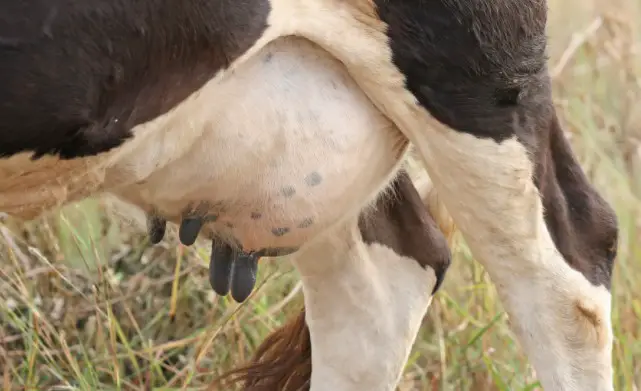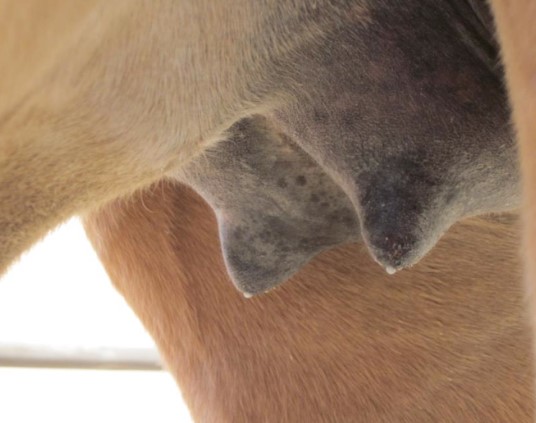From the moment a foal is born it needs to feed on its mother’s milk for nutrition. Automatically, we equate baby’s milk with udders, teats, and nipples. More often than not, an image of a cow comes to mind. So, what about horse foals? Do mares have udders and teats to feed their young? The simple answer is yes.
Horses do have udders and this article contains all the information you need to know about them. Horses are incredible animals. They have been entwined with human history for centuries and have been used for multiple purposes. As a result, horses have been bred far and wide for their different capabilities. Foals are important for carrying on these bloodlines and the success of the foal is dependent on its mother and her milk.
Do Horses Have Udders Like Cows?
The image of a cow is not far off. There are a lot of similarities when it comes to the milk making appendages of the two animals. However, there are several differences as well. Just like cows, horses also have udders and teats. However, there are some differences. Cows only have one udder that has four teats. Comparatively, horses have two udders, each with one teat. Furthermore, a cow’s udder is made up of four mammary glands while a horse’s udder is made up of only two.

That being said, anyone who’s ever tried to milk a horse knows it’s not an easy task. When you look a little bit closer, you’ll find that the teats on horses are much smaller than those found on cows. In addition, each teat contains two small holes at the tip. In contrast, a cow’s teat is rather large, making it easier to milk and to judge the direction the milk will come out in. The small size of the teats of horses and the fact that the openings on the teats can face different directions makes it a completely different experience. Moreover, horses produce only as much milk as their foal requires, whereas dairy cows are bred to produce large amounts of milk for human consumption.
Horse udders are not prone to inflammation like cow udders are either. Cows often get inflamed udders during the milking process. Human hands or milking equipment can introduce bacteria into the udder. If it does occur in horses, it is usually during the final stages of lactation when milk remains in the udder for long periods of time.
What Do They Look Like?
In between a horse’s hind legs is where you’ll find their udders. They are visible in all mares but if a mare has never been pregnant, they remain quite small with only the teats being visible. However, when a mare gets pregnant, they get bigger as the mammary gland begins to produce milk for the foal.
The typical low bearing udders of a cow that sag close to the ground are not what you’ll find on a mare. A horse’s udders are not as large as a cow’s and therefore does not protrude as much from its belly.
Do Horse Udders Change During Pregnancy?
Udders can provide vital clues about whether a horse is pregnant and when they are about to give birth. The gestation period of a horse is roughly 11 months but it can vary by several weeks. This is why horse owners pay attention to the udders. A few weeks before foaling, a horse’s udders become distended. In other words, it gets bigger as the horse prepares for the foal’s arrival.

As the horse gets closer to delivery, the teats attached to the udder also become enlarged. This makes them easily visible and distinguishable from the udders themselves. Finally, a day or so before the foal is born, there is a wax-like substance on the teats. This is basically the nutrient-rich colostrum that the foal will feed on shortly after it’s born.
What About Horse Milk?
The fact that horses have udders is important because their foals depend on the milk that they receive from their mother. There is an incredible amount of care mothers must provide their newborn calf. They begin feeding two to four hours after they are born and it is extremely important that they do so. Just like humans, a mare’s first milk is nutrient-rich colostrum chock full of crucial antibodies for the foal’s immunity. Additionally, the bacteria found on the udder is important for the foal’s gut development.
Foals drink approximately 15 liters of milk a day and can feed up to six times an hour. That is a lot of milk! To accommodate this, mares produce a minimum of two percent of their weight in milk a day. That means a 1000 lb mare produces a minimum of five gallons of milk a day. This high level of milk production continues for the first six months of the foal’s life. During this time and after, the nutrient quality of the milk decreases. It is expected that the foal will gain nutrients from other food sources as they grow.
Mares who are not in the best of health – either under or overweight – are not great milk producers. Surprisingly, it’s not the quantity of milk that is lacking but the quality. It lacks the amounts of nutrients required by the foal.
Horse Udders Outside of Pregnancy and Nursing
A mare’s udders can become enlarged for reasons other than pregnancy. The first is common inflammation or mastitis. This is due to an infection that can come from many sources. In these cases, the udders become swollen. Additionally, the teats may secrete discharge when touched, and there may be signs of pain when touched. Early detection is key to successfully treating mastitis.
Then there’s Cushing’s disease: a tumor in the pituitary gland of the horse. The tumor causes excess secretion of hormones. The hormone prolactin, specifically, can cause a horse’s udder to swell and even produce milk without being pregnant.
Can You Drink it?
Knowing that horse has udders, this seems like a practical question, right? Humans drink cow’s milk, goat’s milk, sheep’s milk, and even camel’s milk. So, horse’s milk doesn’t seem so far-fetched. In fact, milk from horses known as mare milk is rich in vitamin C, polyunsaturated fatty acids, and whey protein making it a healthy option. It is less rich than cow’s milk.
However, horses only produce milk when they need to feed their foal. This is the main reason why mare milk isn’t more widely consumed. Milking a horse as difficult as it is, will deprive the foal of the nutrients it needs for growth. However, many European countries serve mare milk and in Mongolia, it is considered a favorite delicacy.
Udderly Useful
Horses have udders so that they can feed their young. Foals are dependent on their mother’s milk for the first six months of their lives. Horse udders play a crucial role in storing and delivering the milk to the foal as needed. Even the bacteria on the udder have an important part to play in a foal’s early development! Udders also help horse owners determine when the horse will foal and if something’s wrong. Udderly useful indeed!
